


Because the radio sources are on the arcsecond scale or smaller, the development of a clear picture of the radio properties awaited the ability to image these sources with high fidelity at subarcsecond resolution (the VLA, MERLIN, the EVN and global VLBI networks, and finally the VLBA). Examples of GPS and CSS radio morphology are shown in Figure 6, and statistics are given in Table 4. Pioneering VLBI work on the GPS sources (see, e.g., Phillips & Mutel 1980, 1981, 1982; Phillips & Shaffer 1983; Mutel, Phillips, & Skuppin 1981; Hodges et al. 1984; Jones 1984; Mutel et al. 1985; Pearson & Readhead 1984, 1988) revealed simple, relatively symmetric structure in the radio sources associated with galaxies. These structures were dubbed "compact doubles" by Phillips & Mutel (1982). Deeper images have revealed additional details in the structure of the GPS radio galaxies (see, e.g., Conway et al. 1990a, 1990b, 1992, 1994; Wilkinson et al. 1994; Readhead et al. 1996a, 1996b; Dallacasa et al. 1995; Stanghellini et al. 1996, 1997b; Polatidis et al. 1995; Thakkar et al. 1995; Taylor et al. 1994). The new observations revealed multiple components in the sources, including in some cases the "core" of the radio source. In a growing number of sources, e.g., 0710+439 and 2352+495 (Wilkinson et al. 1994; Readhead et al. 1996b), it seems that the radio structure is "triple" with radio jets and lobes on both sides of a core. These sources with two-sided radio structures have been called compact triples by Conway et al. (1990a, 1990b) and CSOs by Wilkinson et al. (1994) and Readhead et al. (1996b). The term "symmetric" is used by Readhead et al. to mean "two-sided," i.e., there is emission on both sides of the core, rather than implying exact symmetry between the two sides. Although many of the GPS radio galaxies are two-sided, in many cases the morphologies, arm ratios, and flux density ratios are not especially symmetric. This asymmetry may be due to strong interactions of the radio source with the ambient medium.
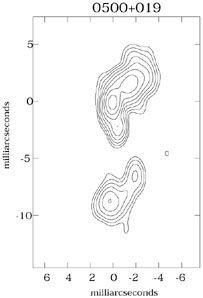 |
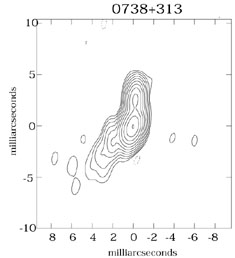 |
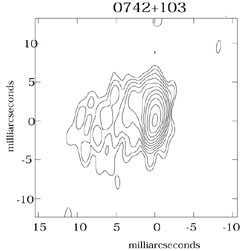 |
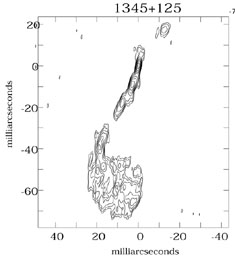 |
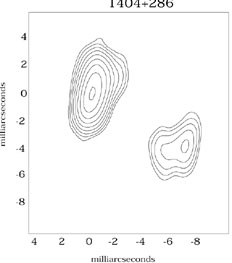 |
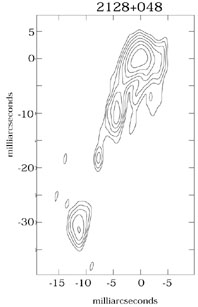 |
Figure 6. Radio images of GPS and CSS sources from C. Stanghellini (1997, private communication; see also Stanghellini et al. 1997b) | |
| Subsample | Total | CD+CSO | Compact | Linear/Core-Jet | Complex |
| GPS galaxies (Total) | 28 | 23 (82%) | 1 (4%) | 3 (11%) | 1 (4%) |
| GPS quasars (Total) | 27 | 8 (30%) | 8 (30%) | 7 (26%) | 4 (15%) |
| GPS galaxies (Stanghellini) | 21 | 19 (90%) | 0 (0%) | 1 (5%) | 1 (5%) |
| GPS quasars (Stanghellini) | 14 | 5 (36%) | 1 (7%) | 6 (43%) | 2 (14%) |
| CSS galaxies | 23 | 21 (91%) | 0 (0%) | 0 (0%) | 2 (23%) |
| CSS quasars | 20 | 17 (85%) | 0 (0%) | 1 (20%) | 2 (10%) |
| Combined galaxies | 36 | 32 (89%) | 0 (0%) | 1 (3%) | 3 (8%) |
| Combined quasars | 32 | 20 (62%) | 1 (3%) | 7 (32%) | 4 (12%) |
NOTES. - The radio morphology as a function of optical identification for the sources for which there are radio images. The GPS (Total) sample includes the master list of GPS sources maintained by the author which is a very heterogeneous list. The GPS (Stanghellini) sub sample is the Stanghellini complete sample. The Empty fields are included with the galaxies and the stellar objects are included with the quasars. Compact sources includes those which are only slightly resolved by the existing data and for which no definite classification can be made. The combined sample is the Stanghellini GPS plus the Fanti CSS with overlap consolidated. | |||||
From Table 4, it is clear that nearly all GPS galaxies have either compact double (CD) or triple (CSO) morphology. The current data suggest that the GPS quasars can have a mixture of morphologies, including compact sources, triples, and core-jet (Hodges et al. 1984; Hummel et al. 1988; Spangler, Mutel, & Benson 1983; Gurvits et al. 1992, 1994; Dallacasa et al. 1995; Stanghellini et al. 1996, 1997b).
A large body of data on the radio structures of the CSS sources has been accumulated (Pearson, Perley, & Readhead 1985; van Breugel et al. 1984b, 1992; Fanti et al. 1985, 1989; Simon et al. 1990; Wilkinson et al. 1984a, 1984b, 1991b; Spencer et al. 1989, 1991; Zhang et al. 1991, 1994; Mantovani et al. 1994; Akujor, Spencer, & Wilkinson 1990; Akujor, Spencer, & Saikia 1991a; Akujor et al. 1991b, 1993; Akujor & Garrington 1995; Nan et al. 1991a, 1991b, 1992; Sanghera et al. 1995; Cotton et al. 1997a, 1997b). The CSS galaxies tend to be (sometimes asymmetric) doubles and triples, while the quasars tend to be triple with a single bright jet (Spencer et al. 1989; Fanti et al. 1990b; Sanghera et al. 1995). Based on early low-fidelity images, the quasars were often thought to be core-jets, but recent observations have shown that they are mostly triples (Sanghera et al. 1995). A similar situation may hold for the GPS quasars. The CSS quasars tend to have brighter jets and brighter cores than the galaxies (Fanti et al. 1990b; Spencer et al. 1991; Sanghera et al. 1995).
Some CSS sources exhibit very distorted morphology (e.g., 3C 287 (quasar), Fanti et al. 1989; 3C 119 (galaxy? see Eracleous & Halpern 1994) - Fanti et al. 1986; Nan Rendong et al. 1991a, 1991b). The distorted morphologies have led to the suggestion that the sources are interacting with dense clouds in their environment (see, e.g., van Breugel, Miley, & Heckman 1984b; Wilkinson et al. 1984a, 1984b). Direct evidence for interactions between kiloparsec-scale radio jets and ambient gas has been found in some objects (e.g., 3C 305, Heckman et al. 1982; 4C 26.42, van Breugel et al. 1984a; 3C 303.1, Gelderman & Whittle 1994; PKS 2322-123, O'Dea, Baum, & Gallimore 1994a). However, in most cases the interaction is merely inferred from the distorted morphology (see, e.g., van Breugel et al. 1984b; Akujor et al. 1991a; Wilkinson et al. 1984a, 1984b, 1991b). In 3C 147 (Zhang et al. 1991) the distorted morphology has also been attributed to the existence of more than one "engine."
The existence of two-sided GPS/CSS radio sources has two important implications. (1) These structures are in sharp contrast to the one-sided "core-jet" structures usually found in powerful compact radio sources (and thought to be due to relativistically boosted jets). (2) There is a continuity in morphology between the GPS and CSS sources and the large-scale radio sources.